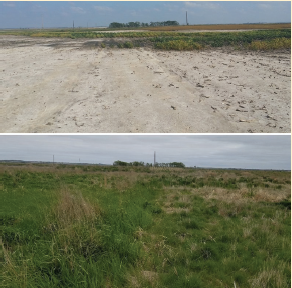Revegetating Saline–Sodic Soils With Salt-Tolerant Grasses

In the Northern Great Plains, there are some 20 million ha of saline–sodic soils, which have become widespread in areas with shallow soils located over sodium‐rich shales from ancient seabeds. Since the early 2000s, rainfall has increased, raising water tables and transporting subsurface salts to the surface. Revegetation of these soils, which are intertwined with highly productive soils, is challenging.
South Dakota State University researchers compared establishment and growth of two mixes of salt‐tolerant perennial grasses in areas too saline/sodic for corn and soybean. In late fall, they seeded either slender wheatgrass plus beardless wildrye; or a slender wheatgrass, creeping foxtail, western wheatgrass, and ‘AC Saltlander’ green wheatgrass mix. AC Saltlander had the greatest biomass based on annual measurements from 2018 to 2021. However, creeping foxtail emerged early, providing protection from spring rains. By 2021, desirable grasses were crowding out foxtail barley and thistle patches. The grasses also spread beyond the planted areas, and soils were drier than adjacent barren areas.
The grass mixtures can be multiuse (habitat and grazing), start growth in early spring, need little maintenance, and stabilize fragile dispersed soils. While the biomass sodium content was high (0.25%), these grasses would be suitable for livestock feed if high quality water is available.
Adapted from Clay, S.A., Fiedler, D., Reese, C., & Clay, D.E. (2022). Restoring ecological function to South Dakota saline/sodic soils using perennial grass mixtures. Agronomy Journal. https://doi.org/10.1002/agj2.21184
Text © . The authors. CC BY-NC-ND 4.0. Except where otherwise noted, images are subject to copyright. Any reuse without express permission from the copyright owner is prohibited.











